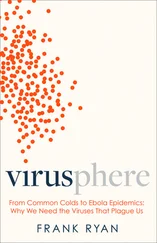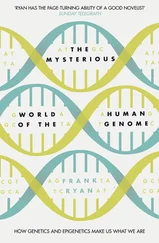1 ...7 8 9 11 12 13 ...20 In fact what he had discovered was that when the offspring inherited two different variations of a gene, sometimes one of the two variations dominated over the other. In the case of the peas, the gene for yellow was dominant. Thus when he blended green and yellow, the offspring, although some only had a single gene for yellow, all appeared yellow. When he further crossbred generations that had one yellow and one green gene, on the law of averages the offspring had a one-in-four chance of having two yellow genes, a two-in-four chance of having one yellow and one green, and a one-in-four chance of having two green genes. Not only does this explain Mendel’s findings, it also proves helpful when we go back to consider the genetics of cystic fibrosis.
Medical geneticists have indeed confirmed that when a child inherits one normal copy of the gene CFTR from one parent and a mutated version of the gene from the other parent, the coding for the normal copy dominates over that of the mutated gene. From the coding perspective, the mutated gene is essentially passive in the presence of the second normal gene. And this, in turn, implies that only if he or she inherits a mutated gene from both parents will a child suffer from cystic fibrosis. In medical genetics, this is known as a recessive pattern of inheritance. From this level of understanding, we see that there are two aspects of the recessive inheritance of cystic fibrosis that make it particularly amenable to gene therapy. The disease is the result of a malfunction of a single gene, CFTR . Moreover, the two defective copies of the CFTR in the sufferer’s chromosomes are passive and can be ignored. All that the sufferer needs to correct the condition is the introduction of a single copy of the normal CFTR gene.
I have no doubt that, in time, it will become possible to correct the genetic cause of cystic fibrosis through the introduction of a single copy of CFTR into the chromosomes of sufferers, though there will be problems, both ethical and technical, to be overcome before we reach this stage. For the moment, scientists have restricted their efforts to gene therapy directed exclusively at stem cells within the lungs, which, to date, have had a limited success.
Other single gene disorders may be the result of dominantly inherited mutations, for example achondroplasia, which causes a profound shortening of the limbs, leading to a common form of dwarfism, and Huntington’s disease, which causes jerky involuntary movements of the body and limbs and a decline in mental abilities. When a mutation affects a gene on the sex chromosomes, the genetics becomes a little more complex. For example, haemophilia, which causes excessive bleeding through defects in the blood-clotting factor VIII, is a recessive condition arising from mutations of a gene carried on the X chromosome. But since males only have a single X chromosome, inherited from their mothers, the single copy of the recessive gene will still give rise to the disease. This is why females, who have two X chromosomes, one inherited from each of the parents, rarely suffer from haemophilia – they would need both copies of the gene to be mutated before haemophilia could manifest. Thus we see that haemophilia is not only sex-linked, it is also a Mendelian recessive condition. Other mutations affecting genes on the sex chromosomes can be dominant, for example the condition known as Vitamin-D resistant rickets, so that a mutated gene on just a single X chromosome will cause the disease in either sex.
To date, geneticists have found causative mutations for more than 5,000 single-gene disorders. Other mutations can change the number of chromosomes, as in Down’s syndrome, where the individual has an additional copy of chromosome 21, or delete, duplicate, fragment, or otherwise damage the structure of chromosomes, giving rise to a variety of medical conditions. While specific gene therapy is at an early stage in the treatment of such conditions, a number of approaches to family screening, advice and prevention are already established and available to assist families known to have an increased risk of mutation and hereditary disease.
The medical approach includes prevention, through genetic counselling, public education about the risks of increasing maternal age, avoidance of risk factors such as radiation of the germ cells and foetus, caution over drug and chemical exposure, such as thalidomide, and vaccination against the rubella virus, which is known to damage the developing foetus. Newer genetic measures, such as in vitro fertilisation of the sperm and egg, followed by genetic screening of the resultant foetus when it is at the stage of a ball of cells, can be offered to high-risk families. Known as pre-implantation genetic diagnosis, or PGD, this may be helpful in a variety of diseases, including sex-linked disorders, single gene defects and chromosomal disorders. The potentially amenable sex-linked disorders include haemophilia, fragile X syndrome, most of the neuromuscular disorders (currently there are more than 900 recognised neuromuscular dystrophies) and hundreds of other diseases. Indeed, the potentially amenable single gene defects also include cystic fibrosis, Tay-Sachs disease, sickle-cell anaemia and Huntington’s disease.
As a general rule, we can see that a genetic abnormality is more likely to respond to PGD if it is predictable, because the genetic inheritance is known, and if its effects can be demonstrated in isolated embryological cells. Some people will have ethical objections to such manipulations of the human embryo, but for governments and the groups who monitor the ethics of medicine, the advantages to families will usually outweigh the ethical worries. It is also important to grasp that pre-implantation genetic diagnosis, with selection for healthy embryos, not only removes the risk of serious disease in an affected offspring but in some cases also eliminates the risk to future generations of the family.
A key development over the last decade or so has been our increasing understanding of the role of mutation in cancer.
But before we enter this intriguing, and disturbing, domain, we should spend a minute or two addressing some key questions as to the essential nature of what we are dealing with. What is cancer? Where does it come from? And why does it frighten us so much?
Cancer is a term used for diseases in which our own body’s cells divide without control and are able to invade other tissues. To put it another way, cells that have been programmed to work in perfect harmony with all the other cells, tissues and organs of the body, go ape and declare violent independence. What is at stake, for the aberrant cells, is immortality. Indeed, cancer cells are immortal in cell culture – but such ambitions are disastrous for the tissue, organ, and individual in which such ambitions arise, since it means that they invade the local tissue, or organ, and from there invade the local environment, or bloodstream, where they cause havoc, and possibly the death of the individual.
There are more than a hundred different forms of cancer, often named after the organ where they occur, such as the colon or breast, or after the kind of body cells they arise from, such as “carcinoma”, which arises from skin, or the cells lining internal organs, “sarcoma”, which arise from internal tissues, such as bone or muscle, “leukaemias”, which arise from blood-forming cells, and “lymphomas” and “myelomas”, which arise from cells involved in the immune system. In the words of Professor Karol Sikora, former chief of the WHO cancer programme, ‘Cancer is frightening because it is the enemy within.’ 4It is also frightening because it is common. One in three of us in developed countries will develop cancer at some point in our lives. In 2008, in the USA alone, some 1,437,180 people were newly diagnosed with cancer, and that same year, in the UK, 1.2 million people were living with the disease from day to day. One of the ironies is that with improvements in healthcare as a result of modern treatments, the numbers of people living with the disease are likely to rise, with Sikora estimating a rise to 3 million in the UK by the year 2020. Indeed, it seems that never a day goes by without a cancer story in the news, with sufferers or their loved ones describing their experiences, and tribulations, on television, in newspaper and magazine articles, or on the personal pages on the Internet. Indeed, if we Google for cancer we discover approximately 300 million websites worldwide. Even the medical term for it and the defining words are hardly reassuring: “a malignant neoplasm”, a disease in which the body’s own cells display “uncontrolled growth”, followed by “metastasis”, which means the invasion of other organs of the body.
Читать дальше












